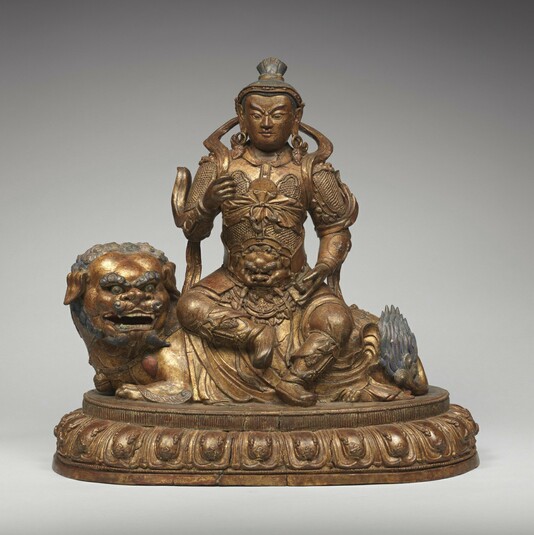
Item: Vaishravana (Buddhist Protector) - Riding a Lion
| Origin Location | China |
|---|---|
| Date Range | 1600 - 1699 |
| Lineages | Buddhist |
| Material | Wood |
| Collection | Rubin Museum of Art |
Classification: Deity
Appearance: King
Gender: Male
Vaishravana Riding a Lion (Tibetan: nam to se sengge shon. English: the Son of Nam To, Riding a Lion): the Guardian King of the Northern Direction, Lord of Yakshas - a class of Indian nature spirits. (See the Vaishravana Riding a Lion Main Page and Outline Page).
Vaishravana, with a regal bearing, has one face and two hands holding in the right a banner of variously coloured silks atop a long staff (missing). The hair is painted blue - traditionally from ground lapis lazuli. In the left, cradled against the side is a mongoose excreting gems from the mouth (missing). The King is adorned with a jeweled crown (missing), earrings and elaborate flowing garments of manifold colours richly textured, along with pants and boots in a central Asian style. The armour of the lower torso is decorated with the image of a Kirtimukha - the Face of Glory - based on an early Indian myth about a heavenly god. With the chest covered by a coat of armour he sits atop a lion with a blue painted mane and tail above a lotus blossom seat.
"With vajra armour, a garland of jewel ornaments and the beautiful heavenly banner - fluttering, illuminated in the middle of a hundred thousand Wealth Bestowers; homage to Vaishravana, chief among the protectors of the Teaching." (Tibetan liturgical verse).
Vaishravana, leader of the Yaksha race of nature spirits, is a worldly guardian worshiped as both a protector and benefactor (wealth deity). He, with his wife - a naga princess - live on the north side of the lower slopes of Mount Meru in the Heaven of the Four Great Kings in a sumptuous palace bathed in green emerald light.
As the leader of the Four Direction Guardians, he at the head of the others, swore an oath of protection before the Buddha - Shakyamuni. Buddhist history relates how the morning after the enlightenment of Shakyamuni Buddha these Four Kings were the first to recognize the attainment and traveled to Bodhgaya, where the Buddha was residing, to make offerings to the newly Awakened One. As a group they presented the Buddha with a black begging bowl made of sapphire (or lapis lazuli). Many images of Shakyamuni Buddha depict him holding a black bowl in the left hand cradled in the lap.
The stories and iconography of the Guardian Kings of the Four Directions arise primarily from the Indian Sutra literature of Buddhism and became common to all schools and traditions of Tibetan and Chinese Buddhism. Lord Atisha, amongst other Indian teachers, popularized the meditation practice of Vaishravana Riding a Lion in Tibet in the 11th century.
A sculpture such as this is typically found along with the other three kings at the entrance to Buddhist temples in China. In Tibet the Four Kings are traditionally painted on the outer walls at the front foyer of a temple, but in China it is normal to create large sculpture made of clay or wood to decorate and protect the entrance.
The dating of this sculptural object of Vaishravana cannot accurately be done by the staff of the Himalayan Art Resources website. A guess of between the 15th and 17th century is offered. The accurate date must be left to the training and expertise of Art Historians who specialize in Chinese cultural art. However, it can be said that this is a very fine example of the subject employing both Tibetan and Chinese artistic elements. The face of Vaishravana and upward flowing garments appear more Tibetan in style. The body shape and details of both Vaishravana and the lion mount appear to follow a Chinese style. Regardless of the mixed styles this sculpture of Vaishravana is an excellent iconographic representation of a popular Buddhist subject as well as being a magnificent work of art.
Jeff Watt 6-2011
(See all sculptural images of Vaishravana Riding a Lion on the HAR website).
Exhibition: RMA Masterworks, January 28th, 2021
Thematic Sets
Buddhist Worldly Protector: Vaishravana Riding a Lion (Iconography)
Buddhist Deity: Vaishravana Riding a Lion (Sculpture Masterworks)
Buddhist Worldly Protector: Vaishravana (Sculpture Masterworks)
Buddhist Worldly Protector: Vaishravana Art History
Collection: Private 5
Sculpture: Kangxi Style, China


